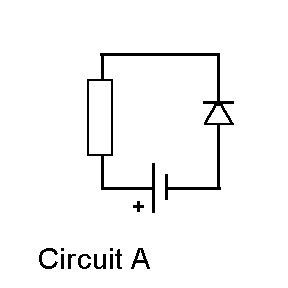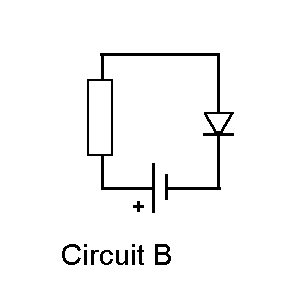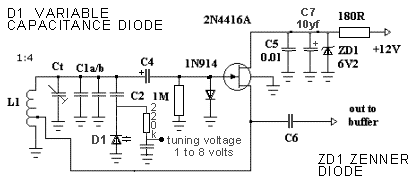Bredhurst Receiving and Transmitting Society |
|
||||||||||||||||||
|
|||||||||||||||||||
3. Technical Basics 3i Diodes and transistors 3i.1 Recall that a diode will conduct electrons only in one direction and that a small forward potential difference (forward bias) is needed to turn the diode on. Let's take a step back and discuss for a moment conductor and insulators. Conductors are materials that have free electrons and insulators are those materials which have no free electrons. We are now going to move onto a material that is partially conductor and partially insulator and it is called a semiconductor.
The circuit diagram for a diode is :-
This component is part of a group of components that use the special properties of materials called "semiconductor" mentioned above to control the flow of electrons (others in the group are transistors, mosfets and leds (light emitting diodes)). The diode is made up of two distinct parts an "N" type material which has excess of electrons and "P" type material which has a lack of electrons. These two piece of material are joined together and there is the junction between the two materials and hence the name JUNCTION DIODE. The diode, due to its construction, will only allow a flow of electrons in one direction and thus a current will only flow in one direction so they are one way devices. We are only going to consider here conventional current flow or just current from positive to negative. The current flow is in the direction of the diode's arrow symbol and that is the + end. This is important when we are using the diode to rectify a transformer output as you will need to know which is the + terminal and which is the - terminal. As you never obtain something for nothing, for the action of the diode to take place there is a need for a small forward potential (also called forward bias or turn on voltage) to "turn" the diode on. What this means in real terms is say there is a 12V potential prior to the diode then afterwards there would be of the order of 11.4V, 0.6V being the "forward potential".
From the circuits drawn above will current flow in circuit A or B. Here you will have to determine which is the + positive side of the battery and thus recall that it is the "longer" side of the battery symbol. Conventional current flow, and that is the one we all now talk about, is from Positive to negative. So if you wanted to determine what current is flowing in a circuit through a resistor you must first confirm that a current is in fact flowing, particularly when there is a diode in circuit. So check the current flow from positive to negative is flowing through the diode which is in the direction of the arrow. Thus looking at the circuits above you can now determine that only in Circuit B does the battery provide the flow that will pass through the diode and a current flow occur. So if you were shown the diagram of Circuit A there is no flow of current so on an ammeter you would have a reading of 0 Amps !!!
Understand the use of a diode to produce direct current from the alternating current leaving a transformer (rectification). Earlier it was have explained that the AC that leaves a transformer's secondary winding. This AC is of very little use except to say light a torch bulb, as most electronic equipment required a source of DC. From above you have seen how the "diode" can be used to make sure that the current only flows in one direction. Thus when a diode is added to the transformer circuit it can change the AC into DC by suppressing the flow the wrong way.
You have an AC source and want DC then use a rectifier diode Above right the simple circuit represents the transformer with the primary and secondary winding (coils / inductors) and a single diode. Whilst the output from the transformer prior to the diode is still AC the transformation from AC to DC is called "rectification" and in the case of the single diode is called "half wave rectification" as only half the AC waveform is doing any useful purpose. You could say that the AC pulses have been converted by the diode to DC pulses. Identify the AC and rectified (pulsed DC) waveforms.
The DC pulsed is the AC rectified by the use of a single diode as previously shown above. 3i.2 Understand that in a rectifier circuit a capacitor can store a charge during the conducting part of the cycle and release it during the non-conducting part, providing a smoothing effect and a smoother DC output. Identify the resulting waveforms. In the section on capacitors it was explained that a capacitor can be "charged" by a DC source to the potential difference of that source. It has also been explained that a capacitor can hold a charge and can also give up a charge. This ability to charge and discharge can be used to great effect in a simple PSU (power supply unit) when a single diode is used to rectify the AC in the secondary of a transformer.
The above simple circuit represents the transformer with the primary and secondary winding (coils / inductors) the single diode with a smoothing capacitor.
Ensure you fully understand the difference between the three waveforms shown above. Where it is shown that there are gaps these would be very small but could still be seen on an oscilloscope screen. In the last diagram on the right above it assumes that a capacitor is now in the circuit and the gaps disappear but note the falling line between one peak and the next as the capacitor discharges due to the "load" on the output. The capacitor is supplying the current missing from the circuit whilst the transformer is in its negative part of the waveform. The deviation from the full DC potential is called "ripple". If there was no output load then there would be no discharge of the capacitor and the line would remain at the maximum potential level. 3i.3 Recall that a light emitting diode (LED) is made from a material that will produce light when passing a suitable direct current. An LED is a special type of diode. It still allows the current to pass only in one direction but is made of a special material that when the right amount of current passes light is produced. You will have seen many LEDs on hifi and TVs indicating that the unit is on. Only a very small current has to pass at a correct voltage to make the LED light. Too much current can destroy an LED !!! 3i.4 Recall that a variable capacitance diode behaves like a capacitor and that the capacitance can be varied by changing the applied potential difference. VARICAP OR VARIABLE CAPACITANCE DIODE or VARACTOR DIODE TUNING depends upon Reverse Voltage
When DIODES have a reverse voltage applied they exhibit the characteristics of a capacitor. Changing the applied voltage alters the amount of capacitance. Most diodes can be used but varactor diode (D1) is specifically manufactured for use in oscillator and tuned circuit.
Schematic of a varactor tuned Hartley Oscillator Both the Varicap diode and the Zener diode are types of diode. Note variation the triangular shape indicating the association with the junction diode which, is the basic diode for rectification, and is where we started at the top of this page.
|
|||||||||||||||||||
|
|||||||||||||||||||
|
|||||||||||||||||||
|
|||||||||||||||||||

 also called a junction diode.
also called a junction diode.












